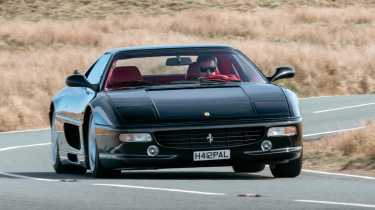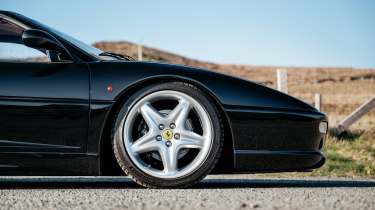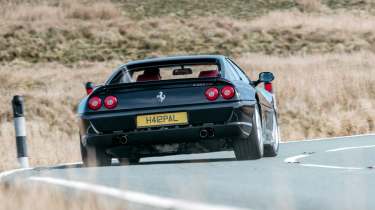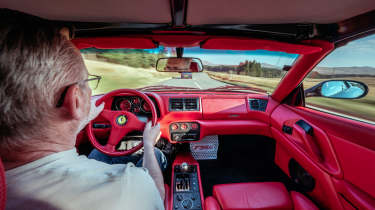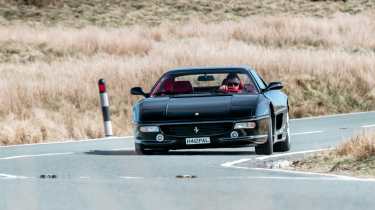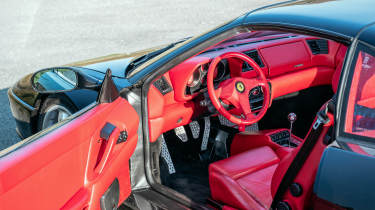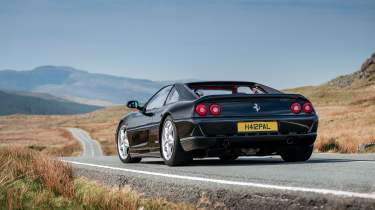Used Ferrari F355 (1994 - 1999) review – a modern classic supercar for BMW M3 money
The F355 delivers on all fronts as a pure-bred Maranello supercar – and you can own one for the same money as a brand new BMW M3
evo verdict
The F355 is in some ways the definitive Maranello supercar. The intense, high-revving V8 and beautifully poised chassis combine to deliver a knockout blow, in a beautifully styled package that seems to get better and better with age. It’s analogue without being uncouth, quick enough to be truly exciting but far from unmanageable. It’s a different thrill to modern Ferraris, putting you in touch with the process of driving and demanding finesse to get the best from it. In other words, it has all the makings of a certified evo icon – and these days, it’s one you can experience for the same money as a new BMW M3.
Background
The scenery of the Cairngorms, normally unparalleled in its beauty, has some almost unheard of competition. It’s in the form of an unfashionably small, low, red projectile traversing it, that’s disarmingly handsome: as far as the subjects of ‘Icon’ features go, few are more worthy than Ferrari’s glorious F355 – a pivotal machine in the history of the most famous car company of them all. And where better to get under its skin than the Old Military Road, a spectacular ribbon of asphalt that runs up the spine of this National Park. It has everything you’ve ever dreamed of in a road.
“Want One”, screamed the cover of the July 1994 issue of Performance Car magazine (evo’s forefather) as it clanked through our letter box. I reached it before the dog, clocked the “Ferrari’s £84,000 bargain” sub-heading with mouth agape, then ruefully pondered on it as I read and re-read the feature aboard the school bus bound for secondary school.
From that day onwards, I have lusted after this relatively simple supercar, watching values plummet but remain far out of reach, and then seeing prices accelerate away once again. Despite these towering expectations, driving one has never been a disappointment. Today, on this road, I’m genuinely fearful the needle on the evo meter might bend and break against the stop.
The root of the F355 story is one of motoring’s eternal pub-talk favourites: the Ferrari 348 was a rotter. Now, I’m not saying those early 348 TBs weren’t poor, but like a lot of performance car history, perceived truths become distilled and streamlined into a simple narrative all too comfortable to repeat.
A late 348 (GTB) is by no means a bad car, but it was that arguably complacent early 348 that looked so half-hearted next to Honda’s sparkling NSX, a car that redefined the concept of a useable supercar. The 348 was neither quick enough, nor useable enough, and simply not very nice to drive quickly.
Ferrari needed a riposte, and damn quickly, the result being a very thorough evolution of the 348. The F355. Although closely related to those late-model 348s, the F355 was a massive step forward and also heralded the return of the beautiful Ferrari after the brash brutality of the 1980s machines.
Engine, gearbox and technical highlights
- Stunning 8500rpm V8 with impressive specific output
- Choice of F1 single-clutch auto or open gate manual transmission
- Steel monocoque chassis, double wishbones and adjustable dampers
I must have missed an entire GCSE Geography module swatting up on the new F129B engine. Ferrari had looked to its contemporary V12 F1 programme, adopting five-valve per cylinder heads that helped raise the rev limit to 8500rpm. Titanium rods helped enable these theatrics, while there was an extra 100cc (achieved via a two mm larger bore taking the overall capacity to 3.5-litres). The result was 375bhp, a massive increase over the 348 GTB’s 312bhp, making the F355’s engine the highest specific horsepower per litre of any naturally aspirated engine on sale. McLaren F1 included.
The flat-plane crank V8 doesn’t actually sound that good when you’re just ambling along. It’s a busy sort of engine note, hard-edged like the tip of an industrial drill, something you’re unable to escape from. It’s only when you exceed 5,500rpm that it homogenises into something petrolheads like us would call musical, which is precisely the point when the F355 pulls itself taut and accelerates with real determination.
There is no definitive opinion on this one, but a vague consensus amongst marque experts suggests that ‘2.7’ cars have a sharper throttle response and more power despite the official claims remaining the same (from so little ‘that you won’t notice it’ to ‘30bhp’, depending on the expert) and that single air mass flow 5.2s have a smoother delivery and idle, whilst obviously being cleaner. The changeover happened for the 1996 Model Year so that Ferrari could sell the car in the US, and around the same time the delectable Momo ‘wheel was changed for a clumsy airbag-equipped design.
When the F355 was launched at the Geneva Motor Show in 1994 it was only available with a six-speed manual gearbox and in GTB (coupe) or GTS (targa roof) form, with a full convertible (the Spider) arriving the year after. The devil’s work /shiny bright future (delete as applicable) arrived in 1997 in the form of the F1 transmission, Ferrari’s first attempt at the single-clutch automated transmission developed from their pioneering work in F1 during the 1989 season. By the time the F355 arrived, any Grand Prix team worth their grid position had a semi-automatic gearbox.
The steel monocoque body, tubular steel rear subframe and unequal wishbones were all Italian supercar staples left fundamentally alone, but Ferrari worked on everything else, rethinking the chassis again from the GTB, incorporating bigger wheels, two-stage electronic dampers and power steering.
The gearbox was now rod operated, not a cable mechanism as on the 348, while more emphasis was placed on aerodynamics with a flip up rear spoiler incorporated into the body, and crucially, a flat undertray.
Driver’s note
‘The F355 was announced in summer 1994, and the only carry-over parts were said to be the roof and glass. The F1 version was a landmark car, a game-changer; very soon more than half of orders were for the paddleshift car, despite it costing £6345 more.’ – Peter Tomalin, evo contributor, who tested the Ferrari F355 in the UK.
Performance, ride and handling
- Deft, exploitable handling compared to the 348
- Surprisingly supple ride for a supercar
- Stunning engine sound and response
To make genuinely rapid progress in a F355 you need to keep the engine spinning between 6,000rpm-8,000rpm+ almost exclusively. Oh man, what a chore. Only kidding – driven thus a F355 is pure bliss, with seemingly no limit to the speed with which cogs can be swapped, the engine revving tirelessly, and the noise consuming everything. Academic now as then, the 0-62mph time of 4.7sec, on the way to its 183mph top speed.
The F355 isn’t intimidating partly because it doesn’t feel that potent through the mid-range. This may have something to do with this example being a later model, or a ‘5.2 Motronic’ car to be precise. F355 aficionados will be aware that when the car was launched it was equipped with a more primitive Bosch 2.7 Motronic system that had two air mass flow sensors, two fuel pumps and two lambda sensors amongst other differences, all clearly visible in the engine bay.
Whatever the setup, the quoted maximum torque figure for the F355 is ‘just’ 268lb-ft at a peaky 6,000rpm. Consider, too, that the quoted dry weight is 1,350kg, so likely to be 1,450kg+ with a full load of fluids, and suddenly that crucial but rarely quoted torque-to-weight figure doesn’t look terribly impressive. This undoubtedly gives the F355’s chassis an easier time of things compared to the kind of volcanic mid-range thrust we expect from a modern supercar, but that doesn’t mask the fact that it’s a gem all the same.
Driving the F355 is really easy but never anything other than extraordinary. There is no form of electronic safety net, but for reasons I’ll come onto in a little while, that’s not a problem – certainly not in the dry. The clutch is agreeably light, and the car is soon moving forwards, requiring your first Ferrari open-gate gearchange. It feels divine. If you’re expecting an awkward resistance, then fear not; the mechanism is fast, and with the guidance of the gate there’s no prospect of miss-slotting a gear. Forget the ‘click-clack’ cliché, the spindly lever makes more of a ‘sckreech’ sound as it squeezes between the metal cutaways, a noise comparable to fingers down a blackboard were it not for the satisfyingly tactile sensations of mechanical components meshing precisely with one another.
After the twitchiness of a 348 TB it takes only 500 yards to get a sense that the F355 is going to be a faithful friend, malleable, exploitable, enjoyable. It rides like a pliantly suspended sled, with the feeling that the track is broad and of a sticky big tyre right at the extremities of each corner.
The winters really take their toll on the road’s surface around here, so for most of the time I leave the dampers in their normal setting, trading body roll for some compliance over the worst of the rutted sections. Like this, the car rides really well, which must make it comfortable as a long-distance car (aided by a pedal box nowhere near as offset as might be expected). The steering is reasonably light, with the whole car feeling delicate to the touch: whether moving the gearlever around the gate or turning into a corner, the F355 is car you tend to drive using just your finger tips once familiarity sets in.
Push harder and the car’s limits are that much more visible, albeit much lower than a ‘modern’. The Old Military Road has a habit of dropping random S bends into ostensibly flat-out sections, and there are some steep, twisting descents at lower altitudes. The F355 pivots somewhere just aft of the driver’s spine, but as it begins to reach the limit of grip it rolls further, leaning on the outer edge of the tyre, starting to arc a wider line at the rear. It’s a process that has several clearly defined stages, in the dry at least, which makes it an easy car to ‘read’.
My only wish – ok, bar a little more torque – is for a slightly quicker steering rack. The F355 is always beautifully poised on the road, but that initial turn in to a corner is never quite as precise as you’d hope, always requiring a few degrees more lock than the brain expects is required. The car is never quite as agile in reality as you know deep down it could be.
The dream solution to this vexing problem is the F355 Challenge, the one-make race car built up in period from a GTB with a kit of official parts. Ferrari never made a F355 Challenge Stradale, but having driven a road-legal example, I can tell you that’s a tragedy worth flooding your garage with tears over to the backing track of some tragi-opera. That early Challenge car (lighter, with any hint of steering vagueness banished, and not yet adorned with the rear wing and non-existent interior of later Challenge cars) remains amongst my all-time top three drives. The Fiorano handling pack, available late in the production run, also got that quicker rack, but only around 14 cars so-equipped made it to the UK.
Still, I can forgive the steering, for it’s a small criticism akin to a minuscule slip of the brush on a mesmerising portrait from a grand master. The F355 bridges the gap between old Ferrari and new; between quaint, classic, small V8s and the last two decades of 200mph supercars; the last hand-built Ferrari, but also the first to really embrace modern technology.
Driver’s note
‘The first thing that strikes you is how supple it is, and how easy it is to drive. I expected it to be hard work at low speed but the steering is light and easy, the gearshift isn’t a chore and the engine is wonderfully smooth. It feels wide but I don’t see why you couldn’t use it regularly – that’d be an absolute joy.’ – Yousuf Ashraf, evo senior staff writer, who tested a manual Ferrari F355 on the road in the UK.
Design and interior
- Bodywork penned by Pininfarina
- Coupe, GTS and Spider bodystyles
- Simple cockpit, open-gate shifter (or column paddles)
What, then, of that body? The pictures tell a story with more clarity than I could ever hope to equal, but go on, indulge me. The F355’s shape is surprisingly cab-forward in profile, the frontal aspect dating the car the most with its flat snout hiding ‘pop-up’ lights, technology from another distant age.
Things get sexier around the sides with the crisp flying buttresses (the last Ferrari to feature this styling device, and also the F355’s biggest corrosion weak-spot) and the loss of the side strakes allowing clean, gaping intakes. But for me the real beauty of the F355 is its bum, specifically the form of those rear wheel arches, their curvature and the perfect bone line that runs through them, then the way it all flows effortlessly, coquettishly into the small integral rear spoiler.
This F355’s ‘Crema’ leather seats are probably what you’d visualise if I said “classic Ferrari interior”. It is disarmingly simple, notably ‘slabby’ around the upper ring of the cockpit, surprisingly ‘normal’ – and for that read ‘comfortable’ - and features one item that more than any other gets the blood flowing through the veins in anticipation: an open gate manual gearbox.
Values today
The cheapest way of getting into a 355 is by going for a Spider with the F1 gearbox, which start from around £70k. Not bad when you consider that a high-flying hot hatch like the Mercedes-AMG A45 S can be specced to a similar price.
For a low mileage F1 coupe expect to pay upwards of £80k, with manual cars commanding hefty premiums. You won't get much change out of £100k for a three-pedal Spider, with GTS’s costing more again, and manual coupes costing £130k and up.
Ferrari F355 specs
| Ferrari F355 | |
| Engine | V8, 3496cc |
| Power | 375bhp @ 8250rpm |
| Torque | 268lb ft @ 6000rpm |
| Transmission | Six-speed manual, six-speed single-clutch 'F1' paddle transmission, rear-wheel drive |
| Wheels | 7.5 x 18in front, 10 x 18in rear |
| Tyres | 225/40 ZR18 front, 265/40 ZR18 rear |
| Weight | 1350kg (dry) (282bhp/ton) |
| 0-62mph | 4.7sec (claimed) |
| Top speed | 183mph (claimed) |
| Price new | £84,000 |
| Value today | From £80k (F1 coupe) |
